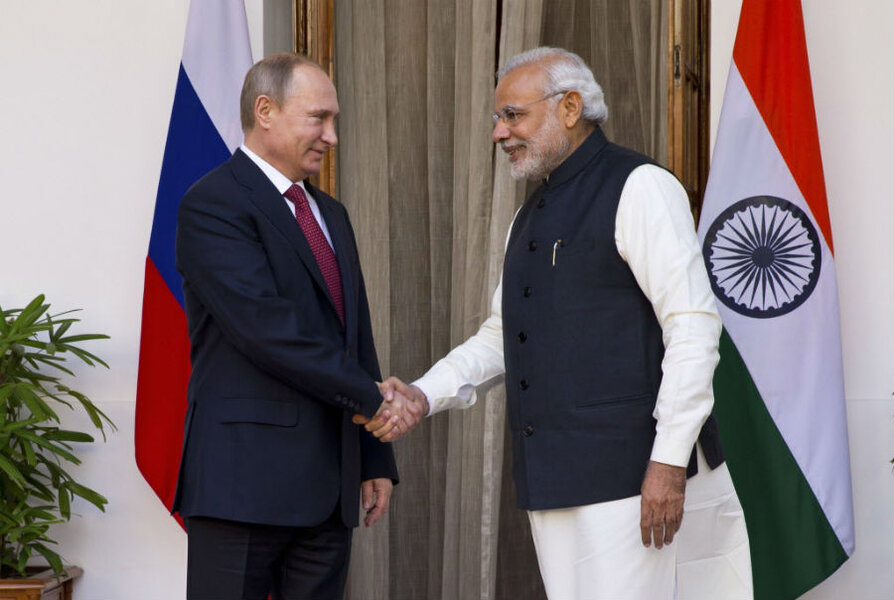How can India be BFFs with both Russia and the United States?
Loading...
| Washington
Just days after India announced with great fanfare that new Prime Minister Narendra Modi will host President Obama in late January for Republic Day, Mr. Modi is heaping the love – and lucrative defense and energy contracts – on Russian President Vladimir Putin.
With the shunned Mr. Putin unable to go West for economic succor for an ailing Russian economy and wary of too-tight an embrace with China, the Russian leader has turned south to OBF (Only Best Friend) India.
Given how the Ukrainian crisis has soured Russia’s economic ties to Europe, Putin’s motivations for muscling up longtime relations with the world’s second most populous country seem crystal clear.
But a more intriguing question is what Modi, who was elected in May and who since has by many accounts developed a close relationship with Mr. Obama, is up to by showcasing not just India’s historically close ties to Russia, but also warm relations with Putin.
Modi’s message seems to be that, even as a growing India with global ambitions expands its horizons to new partners, it’s not going to forget old friends.
The Indian leader also may be signaling Washington – which to Indian thinking has run hot and cold on India since relations first swung upward under George W. Bush – that the United States shouldn’t expect an exclusive relationship.
At an all-smiles Modi-Putin summit in New Delhi Thursday, India signed up for 12 Russian nuclear reactors to be built over the next 20 years, and concluded a 10-year contract for Russian crude oil supplies. India also agreed to a deal under which it will purchase and assemble in India hundreds of Russian helicopters.
“Even if India’s [defense procurement] options have increased, Russia remains our most important defense partner,” Modi said at the summit’s conclusion.
New Delhi and Moscow maintained strong ties during the cold war, united in part by suspicions of the West. More recently relations experienced some rough patches, especially when Russia decided to sell attack helicopters to Pakistan, India’s cross-border rival. Russia was also miffed when India opted to buy some defense hardware from the US and France.
But at a July summit of the emerging-economy BRICS – Brazil, Russia, India, China, and South Africa – Modi assured Putin that their two countries’ bonds were as strong as ever. Any Indian child asked to name his country’s “best friend” would answer "Russia," he said, “because Russia has been with India in times of crisis.”
By comparison, US-India relations have been more of a roller-coaster, even over the past decade and despite a high-profile re-launching of ties under President Bush that included the lifting of a three-decade moratorium on civilian nuclear deals with India.
Indian officials say Modi quickly developed a close relationship with Obama after Modi's election in May. The new leader, they said, was willing to forget that since 2005 and until he became prime minister, Modi had been barred from entering the US over alleged human rights violations. Modi had been accused of doing little to stop deadly sectarian riots that broke out in his home state of Gujarat in 2002 when he was chief administrator.
Still, there was a distinct ring of déjà vu when Secretary of State John Kerry proclaimed on a State Department diplomatic blog earlier this month that India’s and America’s “destinies are converging” and that “our time has come.”
Modi will no doubt embrace the promise of closer economic ties with the US when he welcomes Obama next month. But in the meantime, he appears to be signaling with the Putin summit that India plans to play the field and won’t cast aside old friends.








